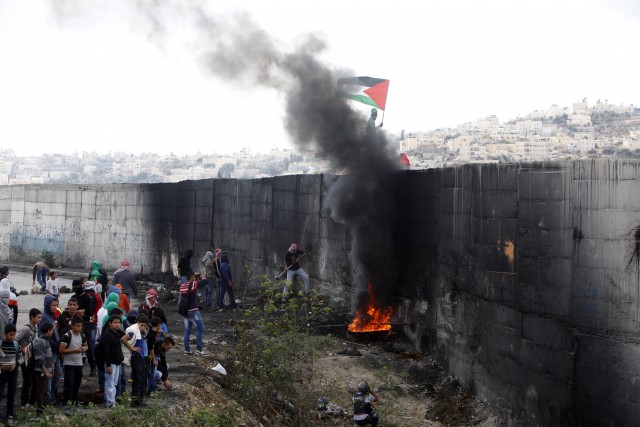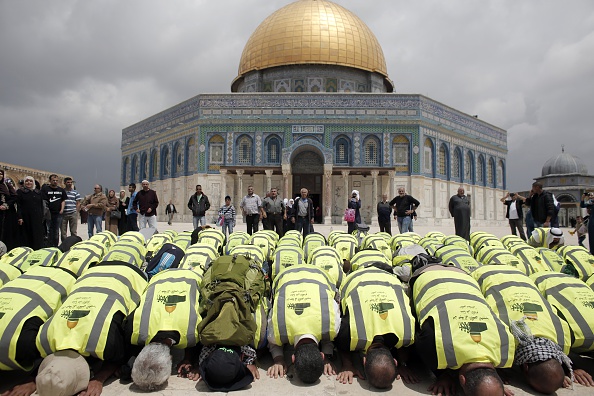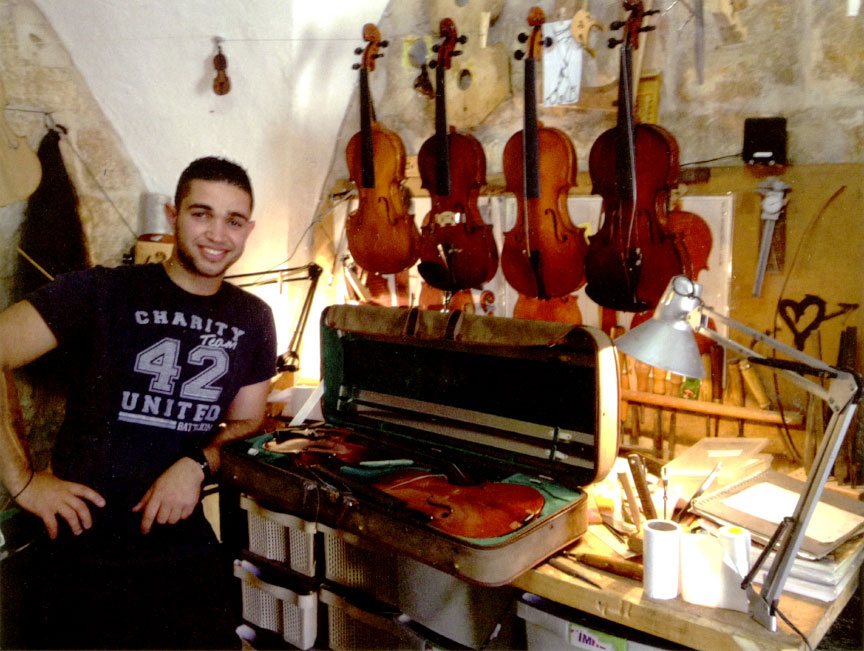These days Jerusalem is a sad and scary place. The city center has largely emptied out. Whether you are Jewish Israeli or Palestinian, there is a sense of lurking danger, random, episodic, entirely unpredictable. Although the number of stabbing incidents has decreased over the last few days, in the street you still sometimes look over your shoulder. People, even in extreme situations, manage to create a veneer of normalcy, easily torn away by the next explosion. But the police report a 2,000 percent increase in the public’s demand for handguns, and the government is easing the process of obtaining one. Once people have guns, they tend to use them.
Fear, also hate, makes for a light finger on the trigger, especially in an atmosphere of rabid nationalism that is deliberately fanned by government spokesmen and the prime minister himself. Army intelligence predicts the current violence will get worse; already, Hamas is said to have directed its forces on the West Bank to carry out suicide bombings. And why should things not get worse? As many of us have been saying for years, this situation is the natural and inevitable result of the Netanyahu world.
When it began some four weeks ago, much of the violence was initially focused on Jerusalem and clearly related to events on the Haram al-Sharif (the Noble Sanctuary, containing the Dome of the Rock and the Al-Aqsa Mosque), which the Jews call the Temple Mount—the most sensitive spot in the Middle East and always a flashpoint for potential conflict. For the last several months, before the current wave of violence, there has been a small-scale Intifada in Palestinian neighborhoods in the eastern part of the city; young Palestinians have been battling police and soldiers there night after night. These confrontations escalated out of control in September and October largely because of the perceived threat to the Haram, especially the possibility that groups of religious Jews will be allowed to pray there or even to build some synagogue-like structure. There was also the matter of police raids on the Al-Aqsa mosque, allegedly to search for weapons and explosives.
Palestinian fears that the Zionists intend to harm, perhaps destroy, the Haram go back to the very earliest years of the struggle in Palestine, long before the creation of the state. This anxiety is not entirely baseless. Official Israel, under pressure from abroad, has reaffirmed (via mediation by Jordan) its commitment to the existing arrangements on the Haram, still largely run by the Waqf, the Muslim Endowment Board, with only collective Muslim prayer allowed there. But we have a Jewish extremist fringe, led by crazed and vicious men such as Moshe Feiglin—a convicted criminal, a settler, and who also, to our shame, was until January a member of the Knesset—who are continuously trying to establish some form of permanent Jewish presence on the Temple Mount, including a building and ready access to the Haram by these hyper-nationalist fanatics.
To comprehend how threatening this is, consider Feiglin’s well-known views: “You can’t teach a monkey to speak and you can’t teach an Arab to be democratic. You’re dealing with a culture of thieves and robbers.” Needless to say, democracy is not high on his list of cherished values, though he may have heard of it. His designs on the Haram are public knowledge—including among Palestinians. He was allowed to enter the Haram less than a year ago, setting off a wave of violence in east Jerusalem. The riots that broke out in September this year in and around the Al-Aqsa Mosque reflected a realistic Palestinian-Muslim awareness of what such people, including members of the present government and the Knesset, want to do.
Miri Regev, the Minister for Culture and Sport, yet another crazed hyper-nationalist, has been agitating for months to establish Jewish prayer sites on the Temple Mount. On October 26, the vice-foreign minister, Tzipi Hotovely, announced that her dream was to see the Israeli flag flying over the Haram. Even if we put aside the profound foolishness of this fantasy, to parade it in public is probably in itself enough to provoke another Intifada. Dreams, or nightmares, of this sort cause innocents to die.
And indeed, from the beginning of October we have had a series of almost daily stabbings and vehicular attacks, many of them by Palestinian teenagers. Two of these youths, from the east Jerusalem neighborhood Jabal Mukkaber (another Palestinian area that has been subject to provocative Israeli settlement), told police they were acting in order to save the Haram. By the end of October ten Israelis had been killed and more than a hundred wounded. Many dozens of Palestinians have died, some in Jerusalem, more in the course of violent demonstrations in the West Bank, and over two thousand have been wounded. These numbers are close to those of September-October 2000, when the Second Intifada broke out in response to Ariel Sharon’s heedless march on the Haram with a thousand armed policemen to protect him.
Advertisement
Most Israelis profess to be surprised at the current outbreak. It has apparently never occurred to them that one cannot occupy the lands of another people for half a century, deny them elementary human rights, disenfranchise and humiliate them, repeatedly demolish their homes and villages, harass and even kill them with impunity, without at some point facing furious resistance. It has been over ten years since the height of the Second Intifada, long enough for a new generation of Palestinians to emerge, traumatized by the occupation, witnesses to the remorseless land-grab for Israeli settlement. I have no doubt that many young Palestinians today are prepared to fight. Some, I believe, will choose the path of non-violent resistance, which may yet achieve mass dimensions—if not today, then tomorrow.
Disingenuous surprise at Palestinian resistance has its intimate twin—the Netanyahu vision of eternal war, articulated in these very words on October 27: Israel will “forever live by the sword.” This means, he explained, that Israel has to maintain total control over all of historic Palestine, including, of course, the occupied territories. So much for the dream of Palestinian statehood and freedom. The Prime Minister apparently thinks Palestinians, all Palestinians, are demonic beings only too eager to destroy the Jews individually and collectively. Witness his ludicrous remarks on the eve of his recent trip to Germany, when he claimed that the notorious Mufti of the 1930s and 1940s, Hajj Amin al-Husseini, gave Hitler the inspiration to kill the Jews. For Netanyahu, all Palestinians, including Abu Mazen and the rest of the moderate leadership in Ramallah, are some version of the Mufti. It does no good to cluck in dismay at such fantasies, which among other things create a false, racist Muslim genealogy for the Holocaust. Netanyahu’s statements, I believe, are not merely manipulative (though they are certainly effective in some quarters, as demagoguery often is) but must in some measure reflect his true, impoverished consciousness. Several psychologist friends of mine think he is clinically ill. Whether he is or not, he is all too likely to create in the real world the paranoid nightmare in which he lives.
Quite apart from the clinical picture, there is Israel’s spiritual crisis—though “spiritual” is a word I rarely use and have, in fact, banned from my university classes on India. But I do not know what else to call the abject failure of the imagination and ever greater hardening of the heart on the part of so many. For half a century we Israelis, as a people, have treated Palestinians, both inside and beyond the Green Line, with arrogance, malice, and a coercive selfishness that makes a mockery of our common humanity. It would be good if we could acknowledge even a little of this history, sadly rationalized by the religious right in the name of supposed Jewish themes such as the sanctity of the Land of Israel or the sorry chosen-ness of the Jews or the God-given enmity of our enemies. Someday, I believe, we will be able to see this, but it won’t happen very soon.
True to their narrow vision, the government and the army have reacted to the violence with even greater violence. There is the familiar Hebrew proverb: “If force doesn’t work, use more force.” Perhaps in the short term they will succeed in stuffing the genie back into the bottle. Already, beginning on October 14, much of east Jerusalem has been blocked off by new walls and crossing points, an amazing re-division of the city by the Israeli right, which has always refused to contemplate such a separation of the two urban segments. Netanyahu is also threatening to revoke Israeli residency for tens of thousands of Palestinian east Jerusalemites, another typically savage act.
But in the long term, the whole program of continuous annexation and violent coercion can only break down and destroy its perpetrators. It is possible that this has already begun to happen. I think that the violent suppression of violent protest is, in this case, a good example of what Hannah Arendt called “the impotence of power.” She makes an important distinction. “Power and violence,” she writes, “are opposites; where the one rules absolutely, the other is absent.” Moreover, “the loss of power tempts men to substitute violence for power.” Appearances to the contrary notwithstanding, Israel’s power to impose its will on Palestine may be slowly unraveling.
Advertisement
Today Israel rules over several million Palestinians, the vast majority of them peaceful civilians who want to have the kind of normal lives that Israelis have or think they have. A Palestinian friend of mine from South Hebron recently said to me:
All I want is to have my dignity recognized and to be able to live in peace, cultivating my lands. I don’t want anyone, Jew or Arab, to get hurt. I don’t want to see my lands stolen, I don’t want settlers to beat me up or shoot at me, I don’t want them to uproot my olive trees, and I don’t want to have to get a permit to visit my family in Jerusalem or Amman or to travel to the next town. I want to be able to get to a hospital if I’m sick without being held up for hours at the roadblocks. Why don’t the Israelis understand this?
This man is a gentle person; over the last two years, we managed, by the classic methods of nonviolent protest and a semblance of judicial process, to restore to his extended family a very large swathe of lands in the southern West Bank, lands that settlers, or rather the state that supports them, had taken away. We have such small, or perhaps not-so-small, victories all the time. They do not change the reality of state terror that shapes the lives of all Palestinians in the south Hebron hills. Meanwhile, in the east Jerusalem neighborhood of Silwan, which settlers call the City of David, we are seeing accelerated processes of dispossession and expulsion of Palestinians from their homes—on October 19th, two families of the large Abu Nab clan were evicted from their houses, which were handed over to Israeli settlers—and a regime of ongoing, routine brutality by soldiers and police.
It’s easy to fall into despair or something even worse than despair, say a dark and helpless numbness. Nothing is as impervious to hope as a mind locked into prejudice and myth, as most minds are. But if you plow this furrow, as the peace activists do week by week, you also find precarious signals that give reason for hope.
I recommend Sandy Tolan’s book, Children of the Stone: The Power of Music in a Hard Land. Tolan tells the story of Ramzi Hussein Aburedwan, the emblematic poster-child of the first Intifada. Ramzi, still a young boy from the Al Amari refugee camp north of Jerusalem, was captured on film by Keith Dannemiller while hurling rocks at Israeli soldiers in 1988. But he grew up to become a violist, trained mostly in France; he came back to Palestine to found the Al Kamandjati school for music in Ramallah, where young Palestinians learn to play the classical Western repertoire as well as classical Arabic music.
Their concerts, however, take place in unlikely places—inside the Qalandiya border crossing, for example, one of the most traumatizing spots in Israel-Palestine, with the soldiers as their unwilling audience; or at the border-village of Battir, south of Jerusalem, with the soldiers standing nearby, helpless to stop them; or in east Jerusalem, which could only be reached by some of the young musicians by scaling the Separation Barrier, with their instruments, and eluding the army and police. Ramzi describes this kind of action as a “musical Intifada.” Committed to non-violent protest, he says, “I think of the viola as a weapon in my hands that allows me to resist.” Protest has many forms and faces. Perhaps it sounds quixotic—as could be said of much of what today’s activists can do. It doesn’t shake the foundations of the occupation. Not yet.
Sandy Tolan’s Children of the Stone: The Power of Music in a Hard Land is published by Bloomsbury.





